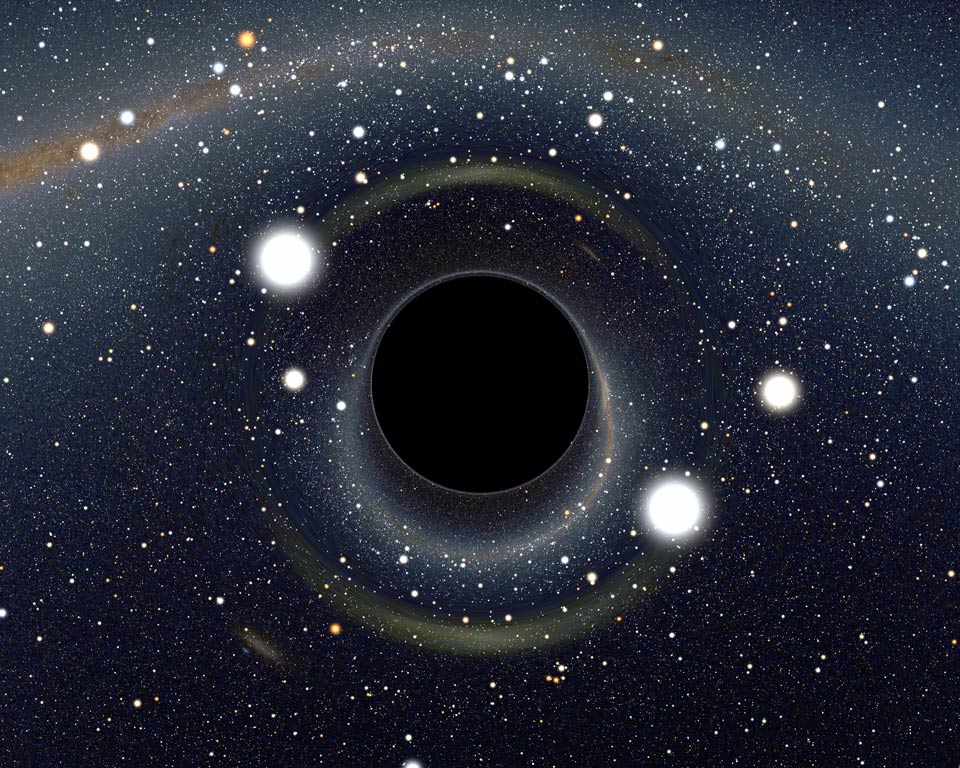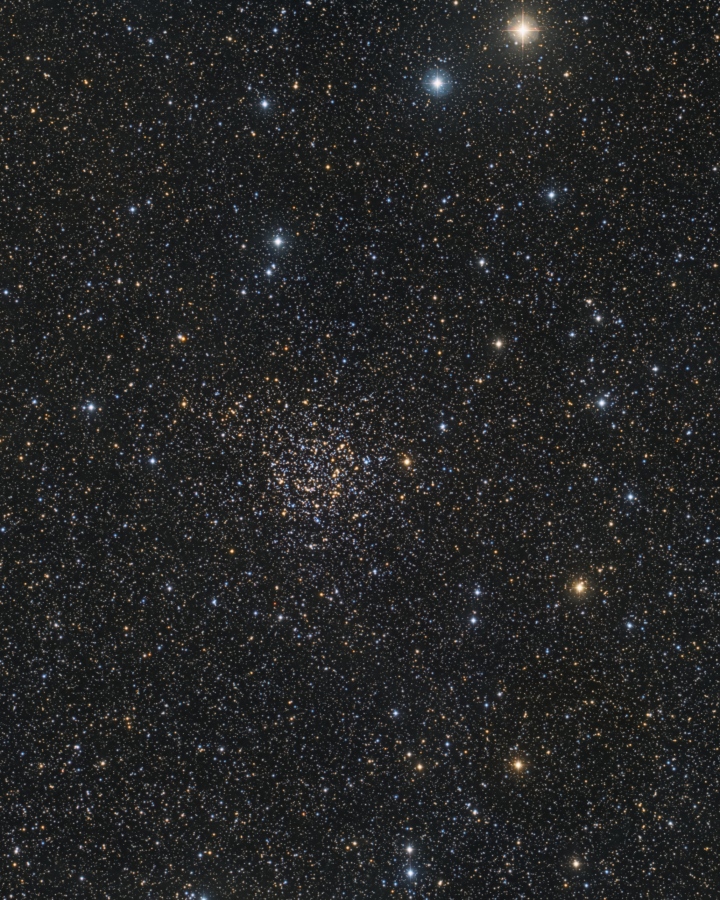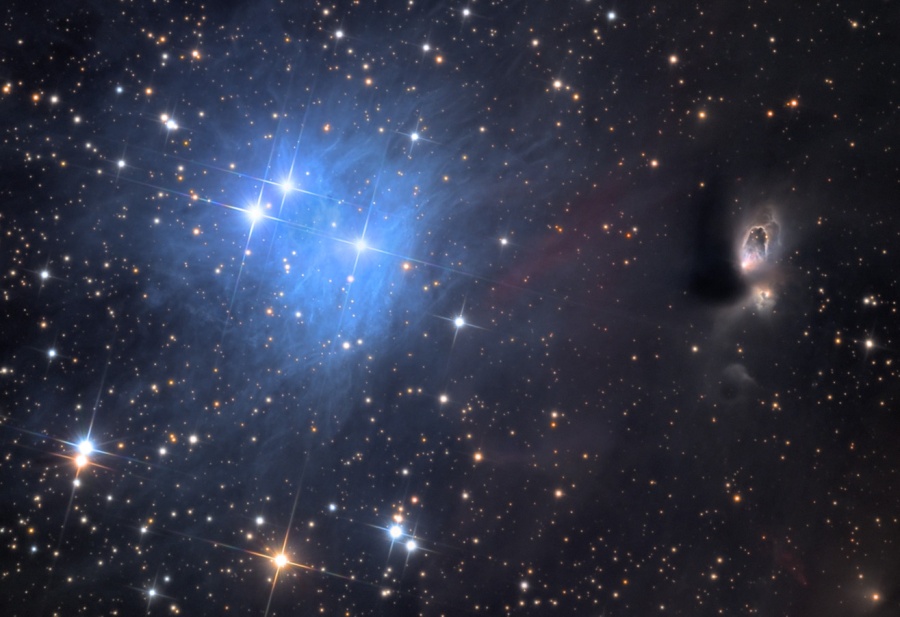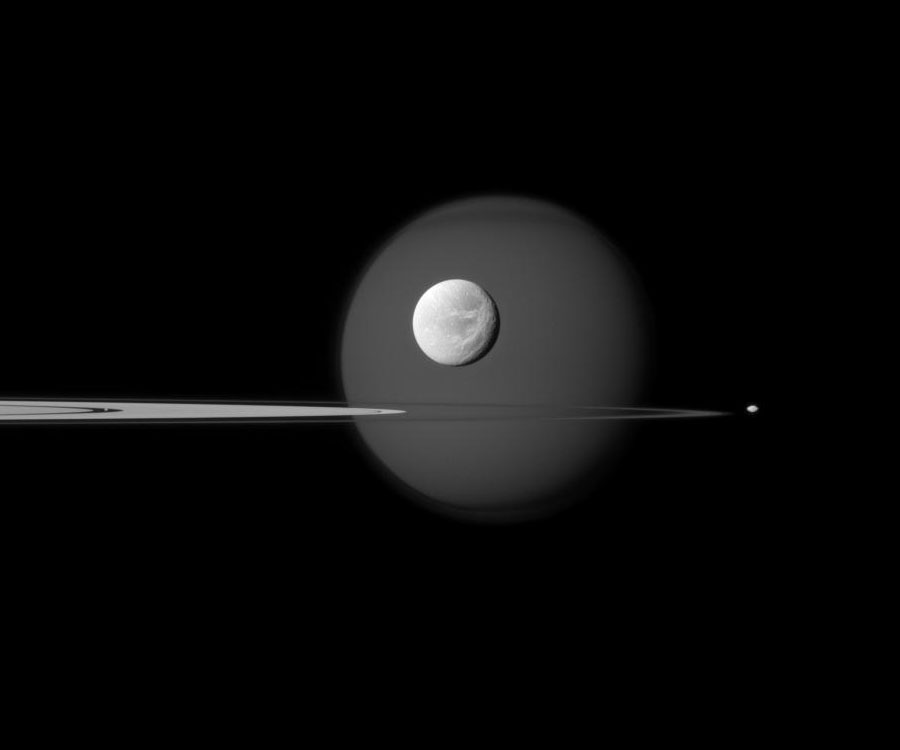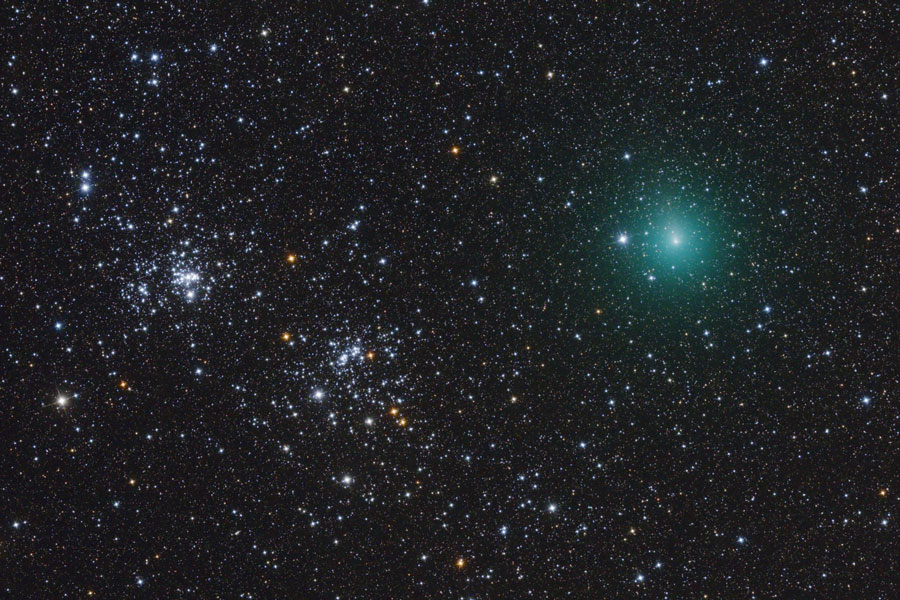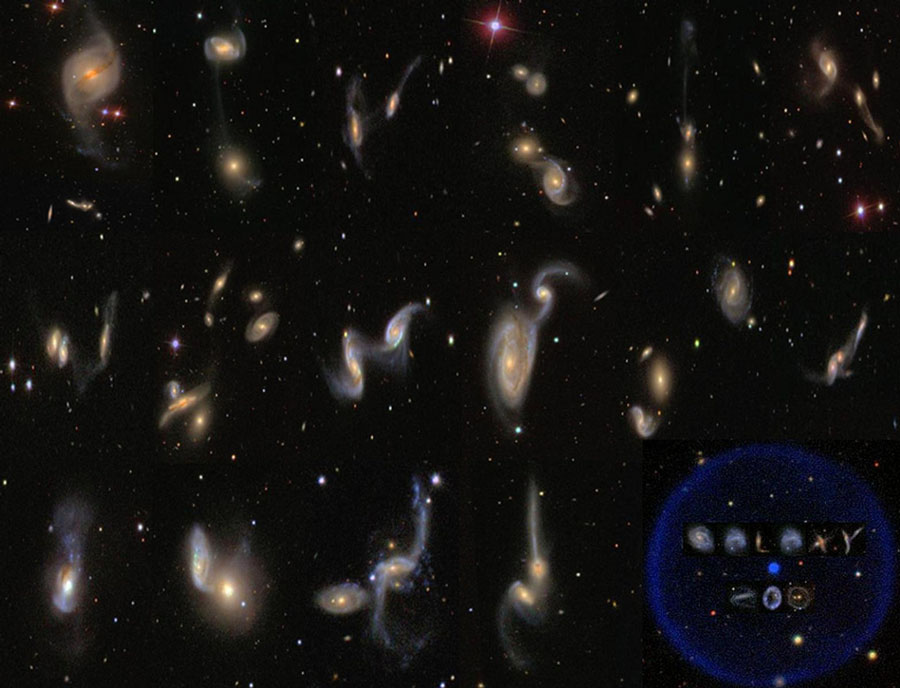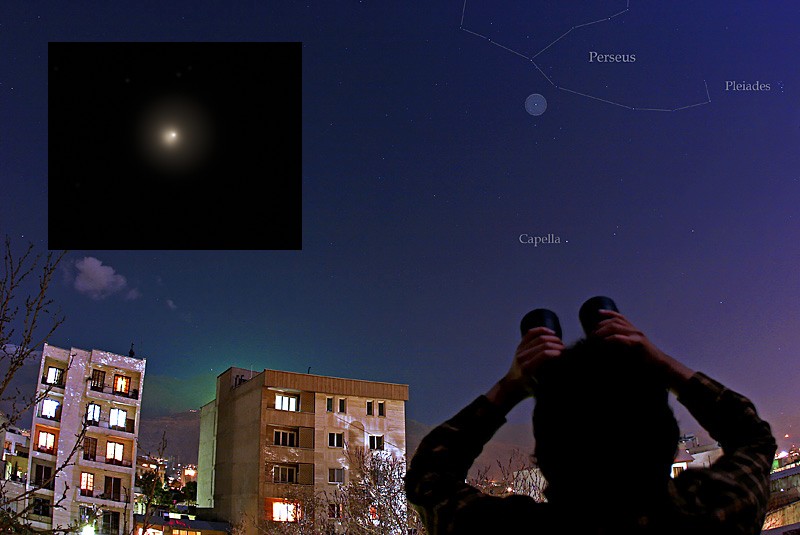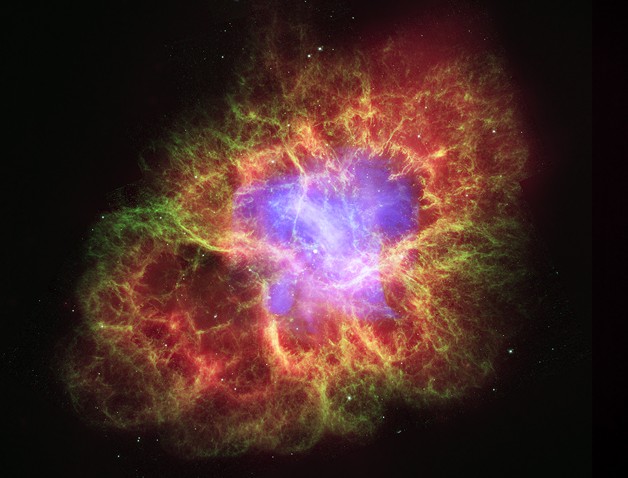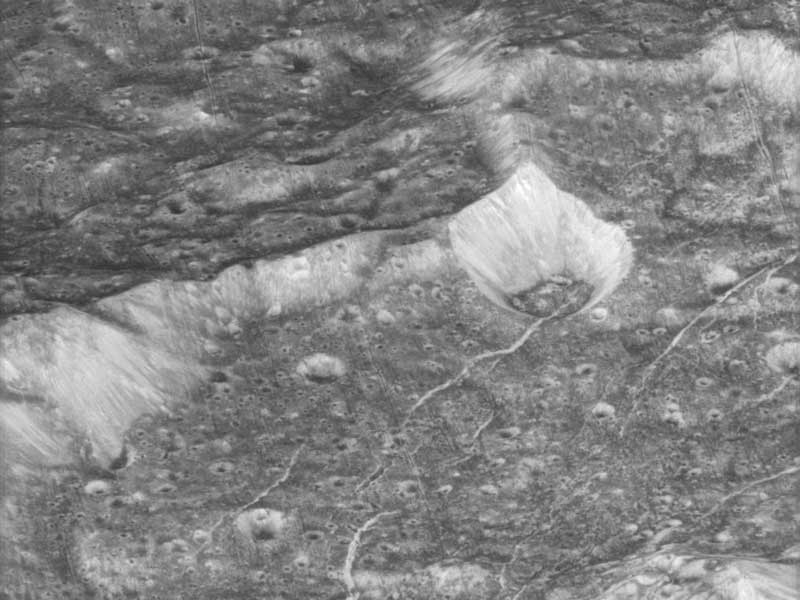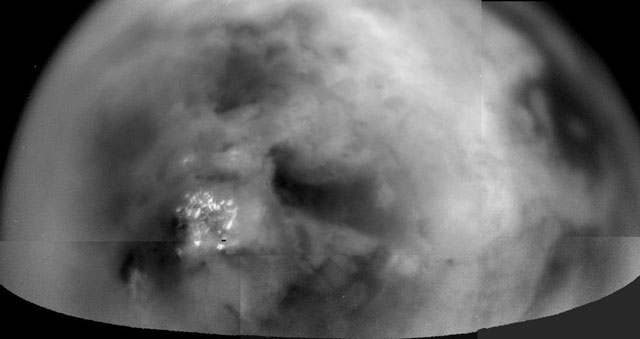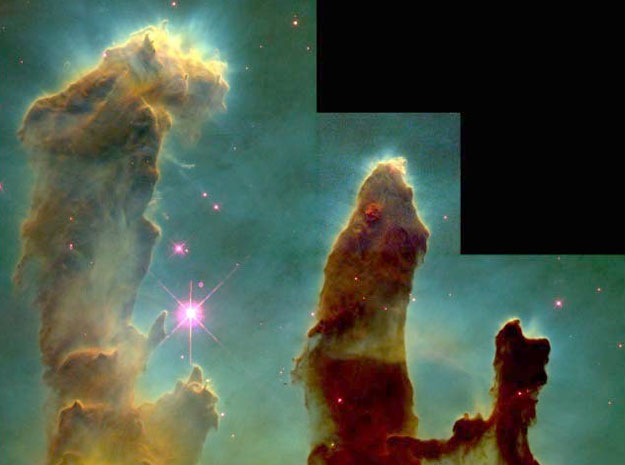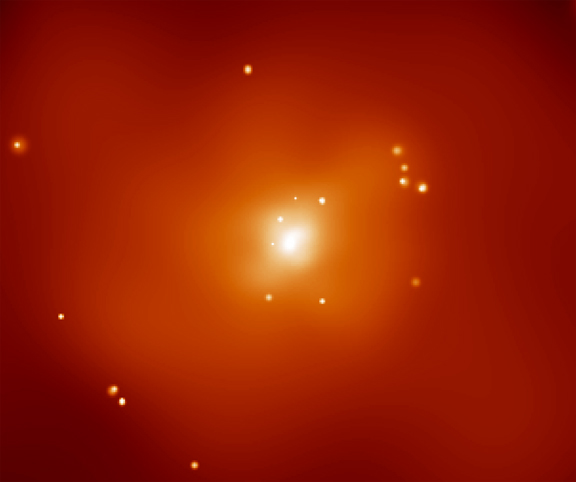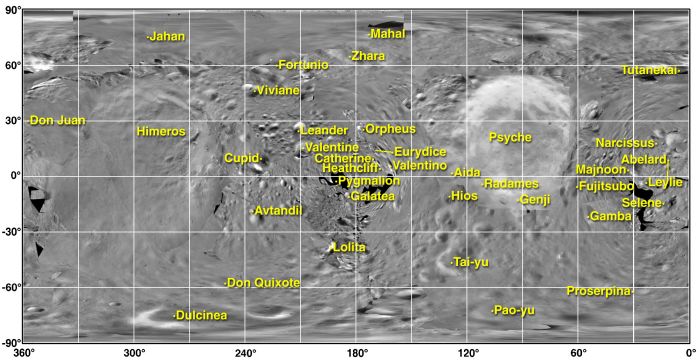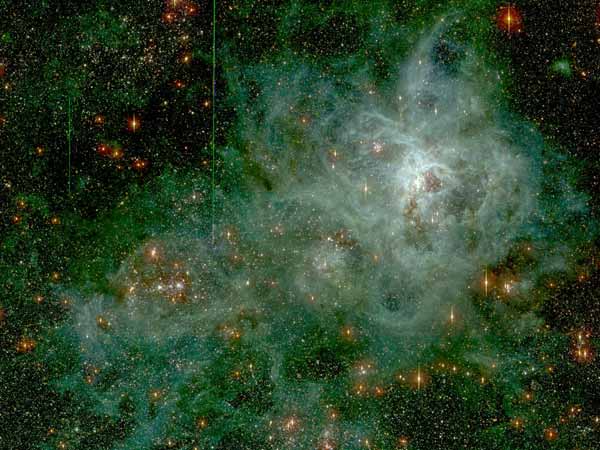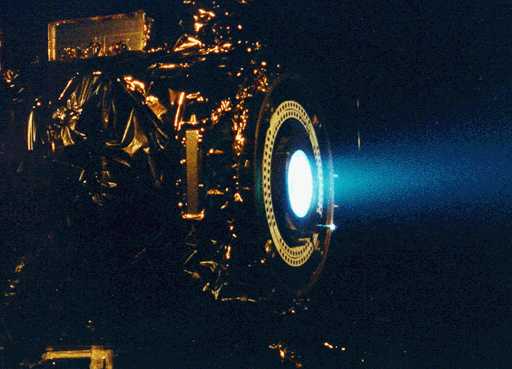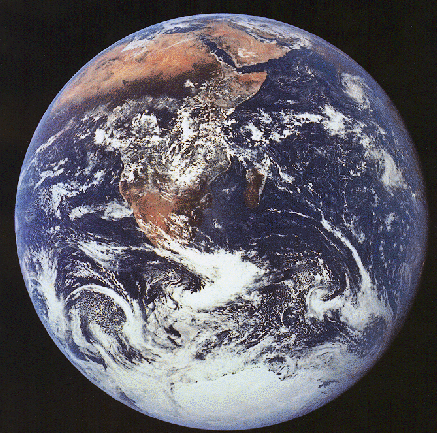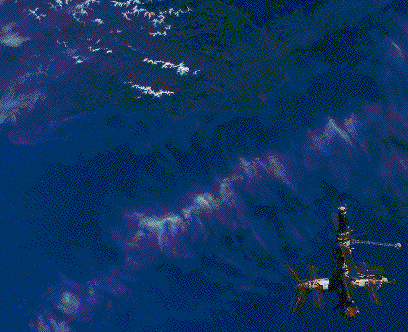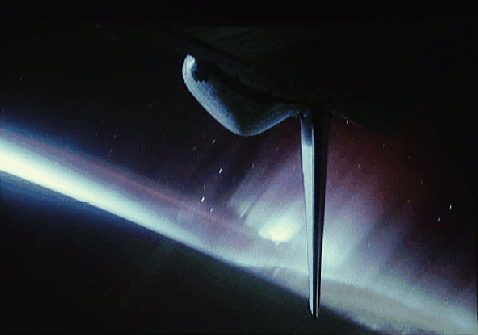| << Previous | Index | Next >> |
2014 What would you see if you went right up to a black hole? Featured is a computer generated image highlighting how strange things would look. The black hole has such strong gravity that light is noticeably bent towards it - causing some very unusual visual distortions. Every star in the normal frame has at least two bright images - one on each side of the black hole. Near the black hole, you can see the whole sky - light from every direction is bent around and comes back to you. The original background map was taken from the 2MASS infrared sky survey, with stars from the Henry Draper catalog superposed. Black holes are thought to be the densest state of matter, and there is indirect evidence for their presence in stellar binary systems and the centers of globular clusters, galaxies, and quasars.
2013 Found among the rich starfields of the Milky Way toward the constellation Cassiopeia, star cluster NGC 7789 lies about 8,000 light-years away. A late 18th century deep sky discovery of astronomer Caroline Lucretia Herschel, the cluster is also known as Caroline's Rose. Its suggestive appearance is created by the cluster's nestled complex of stars and voids. Now estimated to be 1.6 billion years young, the galactic or open cluster of stars also shows its age. All the stars in the cluster were likely born at the same time, but the brighter and more massive ones have more rapidly exhausted the hydrogen fuel in their cores. These have evolved from main sequence stars like the Sun into the many red giant stars shown with a yellowish cast in this lovely color composite. Using measured color and brightness, astronomers can model the mass and hence the age of the cluster stars just starting to "turn off" the main sequence and become red giants. Over 50 light-years across, Caroline's Rose spans about half a degree (the angular size of the moon) near the center of the wide-field telescopic image.
2012 Every book has a first page and every catalog a first entry. And so this lovely blue cosmic cloud begins the van den Bergh Catalog (vdB) of stars surrounded by reflection nebulae. Interstellar dust clouds reflecting the light of the nearby stars, the nebulae usually appear blue because scattering by the dust grains is more effective at shorter (bluer) wavelengths. The same type of scattering gives planet Earth its blue daytime skies. Van den Bergh's 1966 list contains a total of 158 entries more easily visible from the northern hemisphere, including bright Pleiades cluster stars and other popular targets for astroimagers. Less than 5 light-years across, VdB1 lies about 1,600 light-years distant in the constellation Cassiopeia. Also on this scene, two intriguing nebulae at the right show loops and outflow features associated with the energetic process of star formation. Within are extremely young variable stars V633 Cas (top) and V376 Cas.
2011 A fourth moon is visible on the above image if you look hard enough. First -- and farthest in the background -- is Titan, the largest moon of Saturn and one of the larger moons in the Solar System. The dark feature across the top of this perpetually cloudy world is the north polar hood. The next most obvious moon is bright Dione, visible in the foreground, complete with craters and long ice cliffs. Jutting in from the left are several of Saturn's expansive rings, including Saturn's A ring featuring the dark Encke Gap. On the far right, just outside the rings, is Pandora, a moon only 80-kilometers across that helps shepherd Saturn's F ring. The fourth moon? If you look closely in the Encke Gap you'll find a speck that is actually Pan. Although one of Saturn's smallest moons at 35-kilometers across, Pan is massive enough to help keep the Encke gap relatively free of ring particles.
2010 Most star clusters are singularly impressive. Open clusters NGC 869 and NGC 884, however, are doubly impressive. Also known as "h and chi Persei", this unusual double cluster, shown above, is bright enough to be seen from a dark location without even binoculars. Although their discovery surely predates written history, the Greek astronomer Hipparchus notably cataloged the double cluster. The clusters are over 7,000 light years distant toward the constellation of Perseus, but are separated by only hundreds of light years. Captured earlier this month, the bright comet 103P/Hartley, informally called Comet Hartley 2, passed well in front but only a few degrees away from the famous double cluster. Comet Hartley 2, visible on the right, is now fading but still discernable to northern observers with binoculars. No binoculars are needed, of course, if you go right up to the comet's nucleus, as is the plan for NASA's EPOXI spacecraft on November 4.
2009 You, too, can Zoo. The Galaxy Zoo project has been enabling citizen scientists -- inquisitive people like yourself armed with only a web browser-- to sort through the universe. Specifically, after a brief training session, volunteers are asked to use the superior image-processing power of their minds to classify and measure properties of galaxies in the vast Sloan Digital Sky Survey. In its two short years of existence, millions of galaxies have already been inspected by thousands of enthusiastic volunteers. Using Galaxy Zoo data, for example, the universe has been discovered to create no preferred spin direction, an unusual and unclassified object was found that is still being investigated, and a whole class of small galaxies dubbed Green Peas were uncovered where star formation occurs at an extraordinarily high rate. Further, the Galaxy Zoo may be setting a precedent for a new type of scientific inquiry where the web helps collect, focus and coordinate human and machine intelligence. Pictured above, a group of vibrant mergers found by Zooites demonstrates the diverse zoo-like nature of many interacting galaxies in the universe.
2008 How massive can a normal star be? Estimates made from distance, brightness and standard solar models had given one star in the open cluster Pismis 24 over 200 times the mass of our Sun, making it a record holder. This star is the brightest object located just above the gas front in the above image. Close inspection of images taken recently with the Hubble Space Telescope, however, have shown that Pismis 24-1 derives its brilliant luminosity not from a single star but from three at least. Component stars would still remain near 100 solar masses, making them among the more massive stars currently on record. Toward the bottom of the image, stars are still forming in the associated emission nebula NGC 6357, including several that appear to be breaking out and illuminating a spectacular cocoon.
2007 Comet 17P/Holmes stunned comet watchers across planet Earth earlier this week. On October 24, it increased in brightness over half a million times in a matter of hours. The outburst transformed it from an obscure and faint comet quietly orbiting the Sun with a period of about 7 years to a naked-eye comet rivaling the brighter stars in the constellation Perseus. Recorded on that date, this view from Tehran, Iran highlights the comet's (enhanced and circled) dramatic new visibility in urban skies. The inset (left) is a telescopic image from a backyard in Buffalo, New York showing the comet's greatly expanded coma, but apparent lack of a tail. Holmes' outburst could be due to a sudden exposure of fresh cometary ice or even the breakup of the comet nucleus. The comet may well remain bright in the coming days.
2006
2005 What does the surface of Saturn's moon Dione look like? To find out, the robot Cassini spacecraft currently orbiting Saturn flew right past the fourth largest moon of the giant planet earlier this month. Pictured above is an image taken about 4,500 kilometers above Dione's icy surface, spanning about 23 kilometers. Fractures, grooves, and craters in Dione's ice and rock are visible. In many cases, surface features are caused by unknown processes and can only be described. Many of the craters have bright walls but dark floors, indicating that fresher ice is brighter. Nearly parallel grooves run from the upper right to the lower left. Fractures sometimes across the bottom of craters, indicating a relatively recent formation. The lip of a 60-kilometer wide crater runs from the middle left to the upper center of the image, while the crater's center is visible on the lower right. Images like this will continue to be studied to better understand Dione as well as Saturn's complex system of rings and moons.
2004 What are these surface features on Titan? This planet-sized moon of Saturn had much of its south polar surface imaged during an initial flyby by the Saturn-orbiting Cassini spacecraft back in early July. The above image mosaic was digitally stitched together from pictures taken at a very specific color of polarized infrared light, a color not absorbed and little scattered by Titan's methane haze. Visible are light and dark regions that are not yet understood. Surface features as small as 10 kilometers are resolved from about 340,000 kilometers away. The white region near Titan's South Pole, left of center, is unusually thick clouds also thought to be composed of methane. Today Cassini will swoop to within 1,500 kilometers above Titan and may return data and images that help humanity better understand this strange world.
2003 Newborn stars are forming in the Eagle Nebula. This image, taken with the Hubble Space Telescope in 1995, shows evaporating gaseous globules (EGGs) emerging from pillars of molecular hydrogen gas and dust. The giant pillars are light years in length and are so dense that interior gas contracts gravitationally to form stars. At each pillars' end, the intense radiation of bright young stars causes low density material to boil away, leaving stellar nurseries of dense EGGs exposed. The Eagle Nebula, associated with the open star cluster M16, lies about 7000 light years away.
2002 Elliptical galaxy NGC 720 is enveloped in a cosmic cloud of x-ray emitting gas. Seen in this false color image from the Chandra X-ray Observatory, the extreme temperature of the gas - about 7 million degrees Celsius - makes it impossible to confine the cloud to the vicinity of NGC 720 based on the gravity of this galaxy's visible stars alone. In fact, the x-ray cloud is taken as solid evidence for the presence of dark matter surrounding NGC 720 -- unseen material which has gravitational influence that can keep the x-ray hot gas cloud from escaping. Chandra's remarkable vision clearly distinguishes the bright point-like x-ray sources from the diffuse cloud. Astronomers can then use the detailed shape of the cloud to infer the distribution of dark matter in NGC 720 and even test theories about the fundamental nature of dark matter. According to modern understanding, the mysterious dark matter, whatever it is, is by far the most common form of matter in the Universe. Galaxy NGC 720 lies about 80 million light-years distant toward the constellation Cetus.
2001 Massive stars spend their brief lives furiously burning nuclear fuel. Through fusion at extreme temperatures and densities surrounding the stellar core, nuclei of light elements like Hydrogen and Helium are combined to heavier elements like Carbon, Oxygen, etc. in a progression which ends with Iron. And so a supernova explosion, a massive star's inevitable and spectacular demise, blasts back into space debris enriched in heavier elements to be incorporated into other stars and planets (and people!). This detailed false-color x-ray image from the orbiting Chandra Observatory shows such a hot, expanding stellar debris cloud about 36 light-years across. Cataloged as G292.0+1.8, this young supernova remnant in the southern constellation Centaurus resulted from a massive star which exploded an estimated 1,600 years ago. Bluish colors highlight filaments of the mulitmillion degree gas which are exceptionally rich in Oxygen, Neon, and Magnesium. Just below and left of center, a point like object in the Chandra image suggests that the enriching supernova also produced a pulsar in its aftermath, a rotating neutron star remnant of the collapsed stellar core.
2000 This map of Eros was constructed from a mosaic of images recorded by the NEAR Shoemaker spacecraft, currently orbiting the 40 x 14 x 14 kilometer asteroid. A simple cylindrical projection of an irregularly shaped world, the map's individual images don't always match up at the edges. Shown here, place names have been proposed to describe the geography of Eros with a fitting theme, though. They are based on romantic figures in the history and literature of the cultures of planet Earth. The largest feature, Himeros, is a depression about 10 kilometers wide. In Greek mythology, Himeros was an attendant of Eros and the personification of the longing of love. Today, after safely surveying Eros for the past eight months, NEAR Shoemaker is scheduled to make a daring close approach to the asteroid, briefly flying to within about 6 kilometers of its surface. Images returned from that distance are expected to show features less than 1 meter across.
1999 30 Doradus is an immense star forming region in a nearby galaxy known as the Large Magellanic Cloud. Its spidery appearance is responsible for its popular name, the Tarantula Nebula, except that this tarantula is about 1,000 light-years across, and 165,000 light-years away in the southern constellation Dorado. If it were at the distance of the Orion Nebula, the nearest stellar nursery to Earth, it would appear to cover about 30 degrees on the sky or about 60 full moons. The above image was taken with the Big Throughput Camera and is shown in representative colors. The spindly arms of the Tarantula Nebula surround the NGC 2070 star cluster which contains some of the intrinsically brightest, most massive stars known. This celestial Tarantula is also seen near the site of the closest recent Supernova.
1998 Space travel entered the age of the ion drive Saturday with the launch of Deep Space 1, a NASA mission designed primarily to test new technologies. Deep Space 1 is bound for asteroid 1992 KD in July 1999. Although the ion drive on Deep Space 1 provides acceleration much smaller than we feel toward Earth, it will gradually give the spacecraft the speed it needs to travel across our Solar System. The propulsion drive works by ionizing Xenon atoms with power provided by large panels that collect sunlight. As these ions are expelled by a strong electric field out the back, the spacecraft slowly gains speed. Pictured above, hot blue ions emerge from a prototype drive that was successfully tested last year at JPL.
1997 Welcome to Planet Earth, the third planet from a star named the Sun. The Earth is shaped like a sphere and composed mostly of rock. Over 70 percent of the Earth's surface is water. The planet has a relatively thin atmosphere composed mostly of nitrogen and oxygen. Earth has a single large Moon which is about 1/4 of its diameter and, from the planet's surface, is seen to have almost exactly the same angular size as the Sun. With its abundance of liquid water, Earth supports a large variety of life forms, including potentially intelligent species such as dolphins and humans. Please enjoy your stay on Planet Earth.
1996 The Russian space station Mir was photographed last month high above New Zealand. Before returning with record-breaking astronaut Shannon Lucid, the space shuttle Atlantis crew took this breathtaking view from the Space Shuttle Atlantis. Atlantis had just undocked from Mir and was preparing to return to Earth.
1995 Sailing upside down, 115 nautical miles above Earth, the crew of the Space Shuttle Endeavour made this spectacular time exposure of the southern aurora (aurora australis) in October of 1994. The aurora, also known as the northern and southern lights, appear as luminous bands or streamers of light which can extend to altitudes of 200 miles. They are typically visible from the Earth's surface at high latitudes and are caused by high energy particles from the Sun. The delicate colors are caused by energetic electrons colliding with oxygen and nitrogen in the atmosphere. In this picture, the rear structure of the Space Shuttle is visible in the foreground with the vertical tail fin pointed toward Earth. Star trails are visible as small streaks above Earth's horizon.
| << Previous | Index | Next >> |
